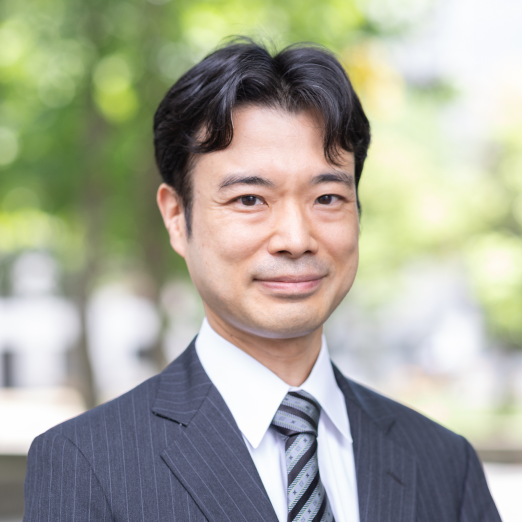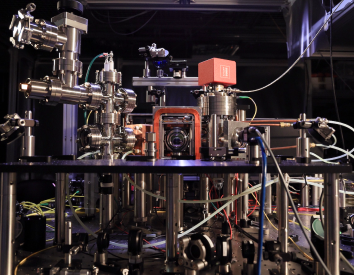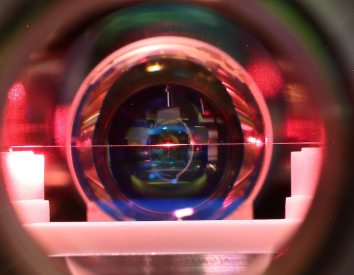
青木 隆朗 教授
Takao Aoki
RESEARCH OVERVIEW
研究概要
青木研は、量子光学を中心にナノフォトニクスから量子情報まで、光科学の最先端の実験を行う研究室です。量子力学では、光(電磁場)も量子化して考える必要があり、古典光学では説明のつかない様々な不思議な性質を持っていることがわかります。このような光の量子性、および光と物質の量子力学的な相互作用について研究するのが量子光学です。本研究室では、光の量子性を実験室で実際に観測し、また光と物質の量子状態を自在に制御する技術の開発を目指します。そのためには、マイクロ~ナノスケールの光共振器や光導波路といった微小光デバイスが強力な武器となります。本研究室では、オリジナルな技術で新しい微小光デバイスを作製し、ナノフォトニクスデバイスとしての応用を探ると同時に、そのようなデバイスを量子光学の実験に適用します。
また、光と物質の量子力学的な相互作用を通して、光を使って物質の量子状態を制御することが可能です。例えば、室温では秒速数百メートルで飛び回っている気体原子の運動を、レーザーを使って一気にマイクロケルビン(速度にして秒速数センチメートル)以下にまで冷却し、さらに捕獲することができます。このようにして極低温にまで冷却された原子は、それ自身の振る舞いに量子性が強く発現するばかりか、原子が光子を放出する過程を制御することで、自然には存在しない量子状態の光の発生に利用することができます。従来の計算機では時間がかかって計算できない問題を一瞬で計算してしまう量子コンピュータや、原理的に絶対安全(盗聴が不可能)な量子暗号などが期待される量子情報。本研究室では、光の量子性を積極的に利用し、量子情報への応用を図ります。
学歴・経歴
2001 年 東京大学大学院工学系研究科物理工学専攻
博士課程修了、博士(工学)
2001 年 東京大学大学院工学系研究科 助手
2007 年 科学技術振興機構「さきがけ」専任研究員
(カリフォルニア工科大学滞在)
2008 年 京都大学大学院理学研究科 特定准教授
2011 年 早稲田大学理工学術院先進理工学部応用物理学科 准教授
2014 年 早稲田大学理工学術院先進理工学部応用物理学科 教授
所属学協会

Takao Aoki
Professor
Field of study
Quantum Optics
Research Themes
Quantum Optics, Quantum Information Science, and Nano-Photonics
Keywords
Quantum Optics, Quantum Information Science, Quantum Electronics, Nonlinear Optics, Nano-Photonics
LINKS
RESEARCH OVERVIEW
Quantum Optics, Quantum Information Science, and Nano-Photonics
A cavity quantum electrodynamics (QED) system, in which an atom is coupled to the quantized electromagnetic fields (light) of an optical cavity, can be described with three characteristic parameters: g, the rate of coherent exchange of energy between the atom and cavity fields, γ, the rate of the decay of the atomic dipole, and κ, the rate of the decay of the cavity field. When the cavity has extremely high finesse and small mode volume, the condition of strong coupling, g >> γ , κ , can be achieved. In the strong coupling regime, coherent interaction of the cavity field and the atom dominates the dissipation of the system, and a single atom gives rise to a strong nonlinearity in optical responses and nonclassical statistics for light at the single-photon level, while a single photon appreciably affects the quantum state of the atom. In such a system, it is possible to generate highly quantum (nonclassical) states or to observe novel phenomena that are normally hampered by dissipation in other systems. This is applicable to quantum information science (e.g., nonclassical light sources, scalable quantum logic with photons, quantum networks connected with light), ultra-low threshold optical devices, and single atom/molecule detecting devices.
Progress in the research of cavity QED has been made with systems of single atoms coupled to Fabry-Perot cavities. In order to overcome the inherent limitation of these conventional cavities for scaling to large numbers and for coupling to single-mode optical fibers with high efficiency, the development of alternative types of cavities has been pursued.
In our current research, we utilize microtoroidal resonators to build on-chip cavity QED systems. Microtoroidal resonators are fabricated by standard lithographic techniques and can be directly coupled to single-mode optical fibers with extremely high efficiency. We are currently working to build scalable multiple cavity QED systems and are seeking for applications to quantum information science with light.
Scanning electron microscope (SEM) image of a microtoroidal resonator, which is monolithically fabricated on a silicon chip by using standard photolithography and etching techniques. The resonator’s quality factor reaches as high as 108.
MESSAGE to STUDENTS
Live your life to the fullest by embracing challenges with all your strength. Find and pursue your one-and-only path that you will follow for a lifetime.
Education and Career
1990: Bachelor of Science, Department of Physics, School of Science and Engineering, Waseda University
1992: Master of Science, Department of Physics and Applied Physics, Graduate School of Science and Engineering, Waseda University
1992–1999: Researcher, Advanced Research Laboratory, Hitachi, Ltd.
1999–2006: Associate Professor / Professor, Graduate School of Arts and Sciences, The University of Tokyo
2006–2016: Professor, Institute of Biomaterials and Bioengineering, Tokyo Medical and Dental University
2016–Present: Professor, Department of Physics, Faculty of Advanced Science and Engineering, Waseda University
Professional Memberships
- Biophysical Society of Japan
- Physical Society of Japan
- Japan Society of Applied Physics
- Biophysical Society (USA)
- Acoustical Society of America


